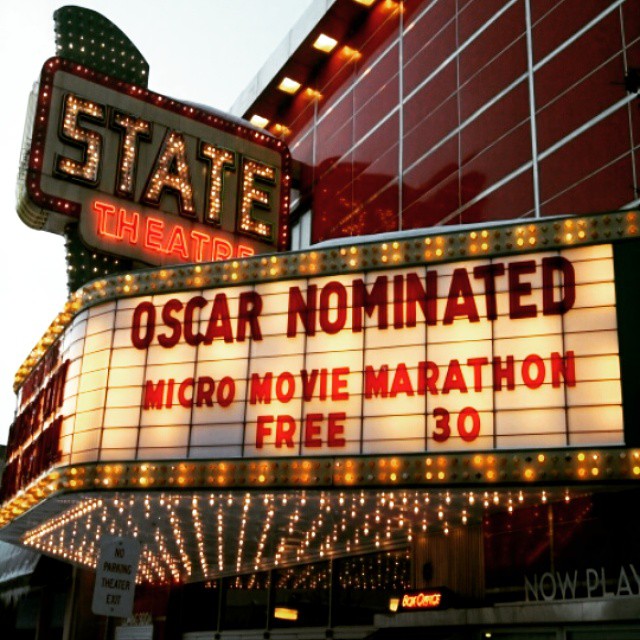The following article is posted as written by Dan Kelly. It is Dan’s explanation of the philosophy and methodology of the M33M festival, his assessment of what went right and what went wrong, his thoughts on making it better next time, and some acknowledgements and thank yous. Please add your thoughts for improving the process next time around.
February 18 was our first screening of the Micro Movie Marathon at the State Theatre. About 90+ people cast ballots. Attendance was pretty decent, considering the snow, bitter cold, and several conflicting events like the Ladysmith Black Mombazo concert. Our largest audience yet.
The first comprehensive debrief, “How to run a Micro Movie Marathon” posted two years back in 2013 when we were screening at the Inside Out Gallery Theater. Coming to the State Theatre was a significant change, so there’s new lessons to learn if we’re invited back.
The evolving mission and driving principles of the Micro Movie Marathon is a good place to start followed by a frank review of what worked and what didn’t.
The Micro Movie Marathon (M33M) is a comprehensive inventory of regional movie making, facilitating feedback and collaboration to support creators who strive to advance and improve.
So that’s the mission. The general public is certainly welcome at the event but it’s designed for local movie makers – as a chance to discover each other, see what our peers are doing and get better at what we do. M33M could be thought of a massive test screening party, with marbles and poetry instead of questionnaires.
Eventually a thriving creator community can transition into a sustainable regional movie industry, defined by Bill Latka as enough living wage gigs to keep all competent creators working full-time.
Although Dan Kelly was one of the founders, Michigan Movie Makers is emerging as an independent entity beyond Dan, and we are all grateful for that! While other events and services will be emerging from the Michigan Movie Makers in the months ahead, each unique sensibilities and objectives, I will continue to plan and deploy host future Micro Movie Marathons. Your feedback for M33M is helpful, especially when the guiding principles are taken into consideration.
The Micro Movie Marathon is designed to
- have low or no environmental impact
- recognize the entire movie making ecosystem
- encourage collaboration over competition
- enable audience interaction and feedback
- celebrate stickiness
Low or no environmental impact
A decade ago I was an assistant to prop stylist Megan Caponetto, fabricating anything and everything for photo shoots, from golden cupid bows to trademarked T’s. Megan didn’t have much storage in her Brooklyn studio so most of our amazing props were dumpstered right after the pictures were taken. I still cringe imagining the daily waste stream from the photo shoots in NYC.
There are several reasons M33M uses marbles and cups instead of paper ballots, but the key one is reuse. All the information needed to vote (movie titles and major award descriptions) was on screen rather than as 500+ paper programs. We had been reusing the same cups and marbles for the last 6 M33Ms, but the larger capacity of the State Theatre required a gear expansion – more marbles, larger cups and bags for easy marble distribution. As a shipping snafu delayed our organza marble bags, we had to go with paper penny rolls, which could have a second life if we can donate them to local banks. The cups need more bold permanent numbers, so the current stickers will have to be discarded and replaced. Other than penny rolls and stickers, the new balloting gear is long lasting.
Changing the throwaway culture requires that we question basic assumptions, especially if we are lucky enough to be creative. Conventional movie productions last longer and require far larger crews than a photo shoot, so the potential for waste is much greater. Setting a precedent for M3 events shapes our fledgling industry, we want to practice a no/low impact ethic from the get go.
Recognizing the entire movie making ecosystem
People of all ages and experience are needed to build a viable industry – entrepreneurs and volunteers, old salts and young whippersnappers. Rather than sorting the movies according to the life experience or virtuosity of the makers, M33M presents a mad mash up, emphasizing that diversity is our strength and the very basis for a viable industry.
From the 2015 entry guidelines…
All genres are welcome – trailers for longer projects, sneak previews, short form narrative, mini documentaries, spoofs, show reels, experimental, beyond category, commercials, promotional, pure art, animation – s’all good!
Collaboration over competition
M33M is about gathering and having a good time together, not pitting filmmakers and studios against one another. The Major Awards are designed to facilitate feedback, not competition.
If the screening sequence was sorted by what and who, M33M would be less about the movies and more about the categories – is this music video better than then last music video? Should an amateurs be held to a lower standard than professionals? Was that movie made by my friends? If all the feature trailers get grouped together, do we then further sort them into genre and then into the perceived experience of the directors? Price of the camera used to shoot? When does it end? For M33M, these questions are not only irrelevant, they take us away from the experience. What the movie is supposed to be or who made it shouldn’t matter, only whether it grabs the audience.
A festival that triggers rivalries and hard feelings will not support collaboration. All categories are based on cultural mores, assumptions that may or may not make sense. Imagine an animated commercial for an insurance company, should that be grouped with a student stop action monster movie (animation) or a live action commercial for edible lingerie (advertising)? In either scenario, two movies are now competing with each other for no good reason, they are totally mismatched. When one “looses” to another it won’t feel fair and animosity could be the outcome. Members of the various teams might be reluctant to work together in the future. Just pour all the milk into the pail and let the cream rise.
After taking in a 2 hour mash-up of 3 minute shorts, only a few movies will stand out – the ones which most touched your heart, fired your imagination or blew your mind. The poetic Major Awards are more like oracles than categories, with a nod to the Tarot, I Ching and the Enneagram, they open awareness rather than restrict possibilities. If the folks in the seats dig a movie, they’ll find a way to make the poetry fit.
This just in – the premise that students should be held to lower standards than freelancers is totally suspect – a high school student just swept all three Major Awards for Winter 2015. Plenty of pros had dogs in the fight. Let the cream rise.
Audience interaction and feedback
The M33M audience are people involved in movie making and those who love them. When people watch work that they helped create, there’s a level of participation beyond what a conventional theater audience might enjoy. If there’s enough time, the balloting involves discussion/debate with seatmates followed by the manipulation of actual objects – putting marbles into movie cups. Paper ballots are less likely to foster social engagement because they are associated to private transactions like school tests and government elections. In contrast, marbles are reminiscent of kid games, so banter and fun are more likely.
The audience gives instant feedback about which of the 40-50 movies really mattered to them, which ones stood out from a slurry of images and sound. Many movie makers are going to be encouraged and others are going to find out that they might want to tweak their projects to improve stickiness. This is a very fundamental sort of feedback, how sticky is my movie?
Celebrating stickiness
Stickiness measures how an idea persists and procreates. Viral media sweeps across populations, exponentially exploding into shared experience, reaching a few hundred or a few hundred thousand depending. The Micro Movie Marathon is the internet in microcosm, a tiny lab where the audience is shown 2 hours of unrelated short movies and then asked to report on which ones they remember, which ideas and images mattered, whether some sounds still echo or feelings resonate. Stickiness is not purely about technical, conceptual, content or performance achievements. A movie is sticky if it finds a little home in the audiences head/heart.
Applying the principles
I’ve been asked several times about my approach to building the screening sequence. I watch all the movies and identify what is sticky and what shows potential. I always include at least one entry from every team, even if I feel an entry is truly forgettable. This is tough, because every movie I include means another (more sticky) movie doesn’t get in. I usually pack the first half with potential and the second half with sticky, with a peppering of sticky at the start. My goal is to keep the audience engaged and to increase their interest as the show progresses. The really sticky work comes in the last quarter.
Wouldn’t the work at the end of the sequence have an unfair advantage by being the most fresh? Perhaps, but movies early in the sequence have taken awards, demonstrating that stickiness can’t be erased by time or even predicted by Dan Kelly.
What went wrong
Not enough time
Plain and simple, we just didn’t have enough time. My error was being too inclusive, screening too many movies for the 2 hour window. There was no time after the movies for an adequate explanation of the balloting process or the process itself.
M33M is 60% movies and 40% audience feedback, eg trying to make sense of the Major Award descriptions, bantering with neighbors about what movies rocked, marble balloting, counting and Major Award presentation.
It was very important that M3 kept the agreement with the TCFF and not run overtime. So we rushed through voting, sealed the jars and got the heck out. Certainly for a 2 hour show, we need at least an hour to vote and award.
3-4 hours would be about right for future M33Ms. Starting with 10 minutes to get folks seated, (previews have conditioned audiences to arrive late), 140 minutes of movies with a 10 minute intermission), 40 minutes of voting discussion, 20 minutes for Major Award presentation and 20 minutes of clean up.
Colors
Marble colors didn’t exactly match the color coded Major Award titles on screen. Reports that the “blue” appeared more purple to the audience. Also the low light of the theatre made it tough to tell which marbles were red.
How to vote
Although the screen was pretty full with movie titles and Major Award descriptions, an explanation of how to vote would have been helpful. Again lack of time exacerbated the confusion.
Major Awards descriptions longish
With adequate time, descriptions over a sentence are fine. The longer descriptions were slightly too complicated considering how little time we had to vote and vámonos.
Exactly 3 minutes
For some reason this year many entrants felt their movies had to be 3 minutes long – exactly. Yikes. M33M entries do not have to be 3 minutes, they should be just long enough. How to say this?
Sloppy mistakes
A couple of movies had extra black at the end and there wasn’t time to trim them. A sloppy mistake by the entrants that need to be addressed in the next entry guidelines. The screening sequencer should be devoting time to high level concerns, not fixing entries.
Don’t get mad, get even. New entry guidelines is a web form that when folks are ready to enter, they go down a checklist and agree to the terms and conditions (no extra black, yes my movie is a maximum of 3 minutes, yes I realize that 3 minutes is a long time and my entry is only as long as it needs to be, I am not swiping screen time from other entrants with pointless fat). Instead of just the usual “√ I have read and understand the terms and conditions”, it would be a multiple choice form that tests their understanding of the event’s premise and terms and conditions, with regenerating questions. If they can’t answer the questions, they haven’t bothered to understand what the show is about.
There’s also a returning entrants form to expedite entry for those who’ve already screened and a secret “I know what I’m doing” form for those who probably do or should – our core.
Didn’t ask for A/V support
The State Theatre audience had trouble seeing hearing me. For simplicity sake, I had opted to just project my voice rather than use a microphone. I hadn’t considered that if I turned to the screen to read / explain the Major Awards, that would be a problem. My projection might not have been adequate, and since I hadn’t asked for a change in house lights, I was hard to see up front – so there was less of a chance to pick up my body language.
Movies misplaced
(At least) one movie was lost during the entry process, Jeff Morgan’s. The email with the link to Jeff’s entry had a subject unrelated to M33M, and tho I had replied, was missed in the final sweep. I could not find an entry or confirmation email for Naomi / Jake who thought they had sent in Fingerslip.
Morgan Burke-Beyers reported that an Up North producer entered two movies via email. She did not receive confirmation emails, and so it’s likely that the emails were lost in transit.
The following was included in the Winter 2015 entry guidelines to catch anyone I might have missed.
You should receive a confirmation email. “IF YOU DON’T GET A CONFIRMATION EMAIL, THEN RESEND! Or call – see the phone number at the bottom of this page.”
Future versions should include a very specific confirmation subject line that is only sent once the entry has been vetted and moved into the sequencing queue
“You should receive a confirmation email. IF YOU DON’T GET A CONFIRMATION EMAIL WITH THE SUBJECT, ‘Confirmed Entry’, THEN RESEND! Or call – see the phone number at the bottom of this page.”
Misspellings
The poster at the State Theatre and flyers read “Theater”. Blog media was updated.
Confusion about what M33M mission and guiding principles
The mission and principles of the M33M were not readily available for entrants or audience members. This caused some frustration confusion about what was presented, “Why are there trailers for bigger movies or advertisements for products? I thought we were going to watch micro movies.”
This post clarifies the mission and guiding principles, and should be reposted as a separate reference document attached to the 2015 summer guidelines. A new question on the guidelines “What is a micro movie?” can be answered with excerpts from ecosystem, genres (see below) and mission (see top).
All genres are welcome – trailers for longer projects, sneak previews, short form narrative, mini documentaries, spoofs, show reels, experimental, beyond category, commercials, promotional, pure art, animation – s’all good!
How to marble harvest
Winter 2015 M33M was a combination of passing the jars and folks chasing them down, which wasn’t ideal. In the future, are the jars moved through the audience or do they come to tables in the theater / lobby?
Need a break before the voting
After the voting, the audience needed a break to stretch and use the facilities before voting.
If the M33M gets a longer slot at the State Theatre, there might even be an intermission between blocks of movies, then a break before the voting. This would make the show more of an event, rather than a screening with a vote.
What went right
Overall
59 movies entered
42 movies screened
Into and out of the State Theatre on schedule
Collected and secured votes for later counting
Interstitials
The interstitial movies between the entries were accurate and looked clean. In earlier M33Ms they were merely palette cleansers, giving the audience a rest from whatever they had just watched, a cognitive reset for the next movie. They also served to re-establish the overall presence of the show and remind the audience where they are and why – you are participating in an important event, and the main themes of that event are… Next time an opportunity – subtly reinforce the driving principles of the event.
This time they also facilitated fast voting by helping the audience remember what they liked because we had the movie just watched and the movie coming up listed. Feedback was that the interstitials did the trick and were helpful – tho we ended abruptly, folks we’re probably able to vote so quickly because movie titles had been reinforced.
For every 6 movies, the 10 second interstitials added a minute to the sequence run time or 7 minutes total.
TCFF and State Theater staff – terrific!
Great support from the projectionists, Joe and Billy
Joe was also very reassuring about running over slightly
Kristen and Meg easy to work with and very encouraging
Ironing out problematic blog language for Golden Reboot
Great support from Tom and Theatre volunteers on the night of
M3 Volunteers – terrific!
Jennifer Cummins coordinating
Great m3 volunteer support, especially Mark Eiden and Jake Burgess for event documentation
Good turn out and volunteers were well organized for start of show
Robin seeks organizes and deploys both swag bags and lanyards
Lanyards gave us a very professional look, coherent
Trickster Pictures team – terrific
Very gungho, Melonie, Bri, Louise – marble shot assembly and other logistics
We had enough supplies ready for full capacity theatre
Dan and Bri count on Saturday with Joe Cissel as independent auditor (no dogs in the fight)
Effective marketing for entries and event
Press releases by Michael
Extensive article in Record Eagle thanks to Allison Batdorff
Interview on WTCM talk with Norm Jones and Bill Froehlich
Traverse City TIcker announcment the day of
Super short festival builds film industry – Traverse City Record-Eagle Lifestyles
Great breakout session afterwards at U and I
Dan got to harangue Richard with Melonie’s help
New connections, new friends
Lots of energy from everyone – Mark, Tim, Matt, Cat, Robin, Josh, Dan et al.





